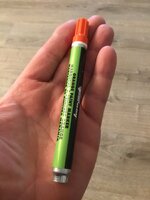What directions do I need to follow?So the consensus is that people can’t follow directions so instead of using thread locker from nasa’s tool box we will use nail polish from Ru Paul’s makeup drawer because it’s more reliable.
All ears.
Follow along with the video below to see how to install our site as a web app on your home screen.
Note: This feature may not be available in some browsers.
What directions do I need to follow?So the consensus is that people can’t follow directions so instead of using thread locker from nasa’s tool box we will use nail polish from Ru Paul’s makeup drawer because it’s more reliable.
I laughed way too hard at this. I’m glad I wasn’t taking a drink of my beer when I read it!So the consensus is that people can’t follow directions so instead of using thread locker from nasa’s tool box we will use nail polish from Ru Paul’s makeup drawer because it’s more reliable.
If you have a singe failure its probably worth the $7 to get a different tube. It’s possible it was compromised or. Expired before you even got it. Loctite explains on their website how to read the date code and location of manufacture on their website.What directions do I need to follow?
All ears.
See my post about using too much. How much thread locker did you apply?What directions do I need to follow?
All ears.
It was multiple failures for multiple users from the same new tube over a several day period with proper prep and torque assembly.If you have a singe failure its probably worth the $7 to get a different tube. It’s possible it was compromised or. Expired before you even got it. Loctite explains on their website how to read the date code and location of manufacture on their website.
Other than that use the smallest amount possible.

I certainly could have applied too much.See my post about using too much. How much thread locker did you apply?
For comparison When I install anything with small fasteners I put a drop of thread locker on the tip Of a screw driver or table and roll the threads over the edge of the drop of threadlocker. I then take the next screw and roll the threads together with the first screw to not only apply to the next screw but to get some of the excess off the first and I never have had an issue. With small screws it’s really easy to add too much and it will not dry properly.
Yes there are standard designations Class 1, 2 & 3 thread tolerances. Class 2 is standard and class 3 is tighter toleranced. Once you get into the fits you have an H# to describe how tight the fit is between both threads.Serious question.
Are female threads in actions, rings, bases etc. Designed and machined to a spec that is airtight with the screws?
Same question about helicopters and such? These have to be to spec right?
Really?
Permatex isn't a favorite of mine. It sucks compared to the Loctite counterparts in my experienceI too have had failures…multiple in fact. This specific new tube on multiple applications after full degrease with acetone.
Fasteners loosened. The solution was still ‘wet’ and had not cured.
Multiple failures within the last 30 days.
View attachment 733424View attachment 733423
It’s really easy to do and tbh I was skeptical until I seen it myself (not with scopes but in the workplace) you wouldn’t think too much of an adhesive would have the opposite effect.I certainly could have applied too much.
So it was likely a bad batch of thread locker that multiple people used.It was multiple failures for multiple users from the same new tube over a several day period with proper prep and torque assembly.
FWIW, after the failures, the fasteners were degreased and dried and made ready for locker and torque.
Used this on the second application
View attachment 733441
It’s available in the welding section of your local purveyor.
They recommend for under 6mm/1/4” to use 222. That is what I use for small fasteners. And yeah, all it takes is one small dot at the start of mby the first two threads. The pictures of drenched bolts using the wrong product might be a clue.Someone else mentioned loctite is not designed for threads under 6mm/1/4”
Maybe for the untrained the Ru Paul products just might be the better way to goSo the consensus is that people can’t follow directions so instead of using thread locker from nasa’s tool box we will use nail polish from Ru Paul’s makeup drawer because it’s more reliable.
Most Permatex products blow! Their silicone sealants also suck compared to the better brands out there. Years ago a manufacturer (Rockwell International) only allowed for two RTV brands to be used to retain warranty status, Dow Corning and GE. Permatex was specifically mentioned as a NO.Permatex
Thanks for the response! I did not know that.Yes there are standard designations Class 1, 2 & 3 thread tolerances. Class 2 is standard and class 3 is tighter toleranced. Once you get into the fits you have an H# to describe how tight the fit is between both threads.
I’d have to read and add all the tolerances for given thread size and class but I can’t imagine both class 2 threads would create a gap that wouldn’t cure anerobic thread locker. That said screws are always a purchase part that often goes to the cheapest bidder and rarely sees QC.
